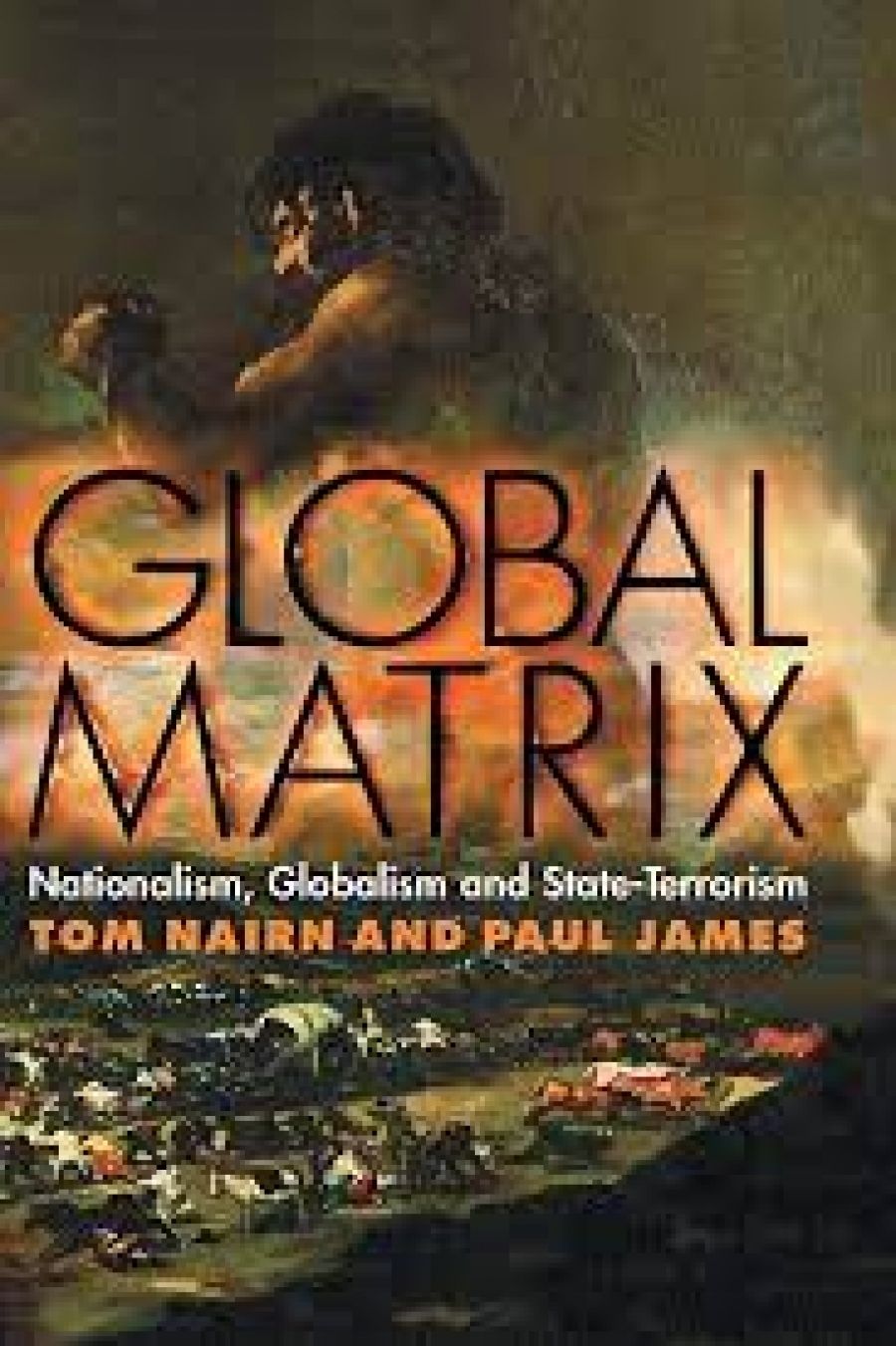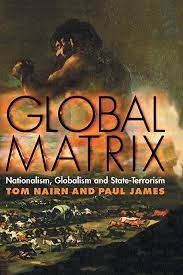
- Free Article: No
- Contents Category: Non-fiction
- Review Article: Yes
- Article Title: Nationalism with a global face
- Online Only: No
- Custom Highlight Text:
Books on globalisation abound, to the point that it has become difficult to say anything new about the issues at stake. But despite this challenge, Tom Nairn and Paul James manage to add substance to the debate. They do so by rethinking the relationship between nationalism and globalisation. The defining feature of this engagement is the authors’ attempt to circumvent what they believe is a very polarised debate.
- Book 1 Title: Global Matrix
- Book 1 Subtitle: Nationalism, globalism and state-terrorism
- Book 1 Biblio: Pluto Press, $52.95 pb, 304 pp, 0745322905
- Book 1 Cover Small (400 x 600):

- Book 1 Cover (800 x 1200):

Scholars tend to engage the challenge of globalisation in two opposing ways. The first is of a communitarian nature. It aims at slowing down or even undoing globalisation, hoping to re-establish state sovereignty in a way that preserves the autonomy and power of the traditional realm of national community and democratic participation. The second and contrasting approach is influenced by cosmopolitan ideas. It fully embraces globalisation and hopes to establish a global civil society and a corresponding legitimate form of supranational governance.
Nairn and James find fault with both cosmopolitan and communitarian approaches. While acknowledging the power of globalisation, even the advent of a new and truly comprehensive global period, they doubt that the associated political dynamics are as novel as some authors suggest. More significantly, they strongly oppose arguments that present the nation state as either empirically or normatively obsolete. This is perhaps the book’s most forceful analytical point: a defence of nationalism in an age of globalisation. This defence begins with an outline of how nationalism emerged as a direct reaction to the onset of globalisation in the eighteenth and nineteenth century. The discussion here is convincing, not least because Nairn was himself one of the key contributors to the early scholarly debates on nationalism, together with authors such as Anthony Smith, Ernest Gellner and Benedict Anderson.
Global Matrix is particularly critical of other authors, including Eric Hobsbawm, who focus mostly on the negative dimensions of modern nationalism. Nairn and James acknowledge that national identity remains a source of conflict, from Bosnia to Rwanda, but add that the same forms of attachment also offer sources of hope. This is the case, they stress, because nationalism has always been much more than commonly assumed. It can provide an important and positive sense of belonging, and thus also the basis for a model of global community and solidarity. The latter, they strongly believe, cannot emerge from versions of cosmopolitanism that seek to speak from a neutral and value-free ‘nowhere’. There is no intellectual space void of history, identity and attachment. At the same time, though, Nairn and James acknowledge the strong impact of globalisation, identifying it as far more than a neo-liberal expansion of economic rationalism and market ideology. Just as important, they stress, are increasing mobility, interconnectedness and the advent – and desirability – of a global search for justice and democracy. The authors employ the term ‘globalism’ to designate this broader understanding of globalisation and the type of political analysis that emerges from it.
The broad scope of Global Matrix is as refreshing as its political tour d’horizon is impressive. While most academic analyses of globalisation and international relations draw upon an unusually narrow set of sources, Nairn and James find inspiration and insight from a wide range of domains. They authoritatively mix high and popular culture, contemporary and historical sources, philosophical texts and empirical phenomena. Goya, Yeats, Swift, Conrad and Musil appear alongside references to The Deer Hunter and Saving Private Ryan, all interspersed with case studies that range from Central Asia to Canada. The result is a stimulating read, though one that presupposes some preliminary knowledge, particularly of the political issues at stake. Without a rudimentary under-standing of, say, the modernisation paradigm or the key debates about nationalism, a reader may have difficulties following the authors’ arguments.
Before further engaging the main themes of Global Matrix, it is necessary to draw attention to its somewhat unusual format. It is a co-authored book, written by two senior scholars working out of RMIT’s Globalism Institute. But with the exception of a jointly written introduction, the main chapters were composed separately, either by Nairn or James. In addition, the book features an extensive discussion of Nairn’s work by Joan Cocks, as well as texts that James co-authored with Andrew Phillips and Ben Wellings, respectively. Global Matrix is thus characterised by a series of relatively independent chapters. Such an approach is more akin to the nature of an edited volume than the type of coherent narrative usually associated with single or co-authored books. This is all the more the case since most of the chapters emerged from previously published essays, many of them in Arena Journal. Add to this the fact that Nairn and James not only have very different writing styles, but also diverge on some of the issues at stake.
The lack of a coherent central voice and narrative does not need to be a disadvantage. It can be seen as a methodological enactment of the very ‘giant-less world’ the authors advocate with their central concept, the ‘global matrix’. Globalisation, they convincingly argue, is a complex, multi-layered and often contradictory set of political, economic, social, and cultural relations. But instead of integrating the ensuing ambiguity into the structure of their own book, Nairn and James co-wrote an introduction in which they present a central narrative that, I think, suppresses some of the heterogeneity present in the chapters that follow. Why not organise these texts simply as a debate between two innovative and sometimes disagreeing scholars? The book could then have been presented as a set of semi-autonomous essays, as Theodor Adorno described them: drifting meditations that resist the problematic compulsion to present everything as objective and systematic – and thus totalising and oppressive.
Nairn and James do more than just analyse the interaction between nationalism and globalism. They also embark on an explicitly normative engagement. The latter parts of the book, in particular, come across as passionate critiques of the militaristic approach to peace and security that has characterised the world since 9/11. The authors are especially opposed to Washington’s ‘neo-imperial foreign policy’, which they believe is slowing down true globalisation. Even though Nairn and James couch their critique in a strong and at times polemical new-left language, most of their arguments against the rationalisation of violence are convincing. Perhaps this is so because their positions are presented as more than a critique of present American foreign policy. They oppose a new period of empire in general, favouring the establishment of a ‘giant-less world’. In such a utopian world, domination and exploitation would still persist, they warn us, the key difference being that existing inequalities would not be naturalised, but constantly challenged through a series of critical intellectual engagements.
I have no quarrel with the authors’ main arguments against militarised approaches to peace, or against a demonisation of national identity, but I wonder if the respective debates are as polarised as Nairn and James suggest. Few authors actually defend the type of extreme cosmopolitan and communitarian positions that are being critiqued in Global Matrix. I also believe it is necessary to make a distinction between foundationalism and universalism. Not all versions of the latter are as problematic as Nairn and James believe, at least not if one constantly scrutinises the contingent foundations upon which they operate. James recognises some of this potential when referring to ‘non-universalizing universalisms’, but does not explore the ensuing potential to its fullest. Some themes and texts could have helped the authors doing so. At an empirical level, I can think of an engagement with the anti-globalisation movement that enacts in practice many of the principles the authors seek to capture in theory with their matrix metaphor. At a conceptual level there is, for instance, Paul Virilio, whose work on speed over the last quarter of a century would have fitted perfectly into Nairn and James’s attempt to rethink the relationship between the (space of) nationalism and the (speed of) globalisation. Likewise, Gilles Deleuze and Felix Guattari’s notion of a rhizome would have offered a promising way of taking the concept of the global matrix a step further. But these are simply reactions of a particular reader, partial as they inevitably are, to a stimulating scholarly work. They are to be read not as critiques, but as proof that Global Matrix can and does generate debate. What more could we possibly wish from a book about a topic as elusive as globalisation?


Comments powered by CComment